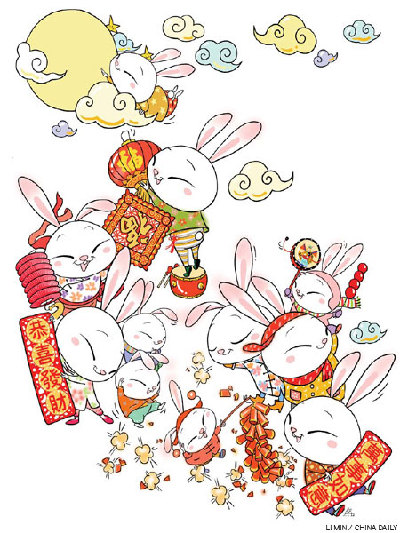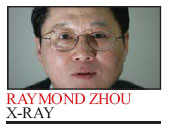

While depictions of these long-eared animals are everywhere as Year of the Rabbit begins, what the creature represents as a totem is as fuzzy as its fur.
In a Year of the Rabbit, images of the zodiac animal are ubiquitous. But despite its omnipresence, it lacks a clear-cut focus, and even worse, it does not have a well-delineated essence. What does the rabbit stand for? People answering this question will cite so many positive qualities as to render the whole point meaningless.
Well, they tend to do that to every zodiac animal during its reign except that, ahem, they have to lie low during the years of the pig or mouse.
The Chinese language does not have equivalents for "rabbit", "hare" and "bunny". All are called tuzi. That is a sign of inattention.
I did a search of tuzi in a Chinese online bookstore, and every title that popped up turned out to be a foreign children's book translated into Chinese. There was no scholarly tome on the cultural symbols associated with the animal. Nor was there any dissection of fairy tales involving the animal or agglomeration of tidbits and traces of it throughout the national psyche.
The rabbit probably epitomizes self-conceitedness more than anything if you take a random survey - but not at the beginning of the lunar year of the animal, when everyone is in a mood to heap eulogies on it.
In Chinese schools, The Tortoise and the Hare has only one interpretation: the hare is foolishly overconfident, and the tortoise has dogged determination.
The tale has been so ingrained into our consciousness that not everyone realizes it is one of Aesop's fables.
In the homegrown canon, tuzi scaled the highest prominence in the moon legend. Any mention of the "jade rabbit" is an allusion to the moon or its goddess, Chang'e.
But is the rabbit her pet or one of her reincarnations? I did a little digging, and uncovered several - often-contradictory - stories of origin.
Tale 1: After Chang'e flees to the Moon Palace (because she stole the immortality pill from her husband), she is punished by the Celestial Emperor, who turns her into a white rabbit. Her job is to work in the heavenly pharmacy.
Tale 2: Three immortals disguise themselves as beggars. They accost a fox, a monkey and a rabbit. The fox and the monkey give them food.
The rabbit says: "I don't have any food, but you can eat me." He throws himself into a fire. The immortals are so moved that they send it to heaven, where it becomes Chang'e au pair.
Tale 3: A pair of rabbits has four beautiful daughters. In sympathy for Chang'e's fate, they decide to send the youngest to her side.
Tale 4: The Jade Rabbit is actually transformed into Houyi, Chang'e's husband. To be with her, he turns himself into a rabbit and lives by her side at the Moon Palace.
Tale 5: Houyi and Chang'e start as gods and descend to the human world. But Chang'e, tired of worldly chores, flees to the moon and is turned into a toad. "Jade Rabbit" is a homonym for her and the result of a linguistic error made in literary transpositions.
I have a hunch the origin is much simpler - someone looked up at shadows on the moon and visualized them as a rabbit pounding herbal medicine. This was then married with the existing Chang'e narrative, essentially turning the rabbit into a sidekick a la Mushu the small dragon in the Disney cartoon Mulan.
Now, if only someone would write up the role of the Jade Rabbit to make it colorful and witty, enlivening the chillier-than-Clair de Lune atmosphere.
The Jade Rabbit has spawned a line of Moon Festival (also known as Mid-Autumn Festival) toys.
Starting from the late Ming Dynasty (1368-1644), Beijing produced clay figurines for holiday celebrations.
The rabbit, or perhaps "bunny" is more appropriate here, is usually portrayed as a male, and occasionally as a female, called "Grandpa Bunny" or "Granny Bunny".
In Beijing dialect, that implies respect, not age.
The bunny figurines are brightly colored and assume an endless variety of postures. These include the bunny as a warrior in shining armor, the bunny riding a lion, elephant or other gigantic wild animal, the bunny flying on the back of a peacock or crane, or the bunny with a human body.
No matter what stance the bunny assumes, he - or occasionally she - has a demure look, clinched by a closed mouth and patches of rouge on both cheeks.
The bunnies serve a dual purpose - they are items of sacrifice for the gods and playthings for children.
Maybe the plaything function, plus the slightly feminine makeup, is what has turned the term "Grandpa Bunny" into a contemporary euphemism for a gigolo. But the tradition is undergoing a revival for the toys - the clay kind, not the boy kind.
Rabbits may be enjoyed in more ways than one. Apart from pets and toys, they find their way onto dinner tables. Rabbit head is a signature delicacy of Sichuan cuisine. It requires 13 ingredients for marinating before it is boiled in spicy broth.
I didn't have the guts to taste it on my trips to the land of myriad spices. In my hometown, rabbit meat does not rank very high on a carnivore's list.
My parents were married in the waning year of the great famine. Their wedding banquet consisted of a single dish, a modicum of rabbit meat, as I was told. They would have opted for pork or beef if they had the luxury.
In my late teens there was a mini-boom of rabbit raising, prompted by a surge in the price of the animal's fur.
Wherever I went, I saw cages with white rabbits inside, nibbling on vegetables provided by the breeders. A year or two later, the bottom fell out of the market just as fast as the boom had arrived. By that time, there were tales of deceit, such as those of retailers hiding an ingot of iron inside a mass of rabbit fur to increase the weight.
Mind you, the rabbits were only sheared for their fur; they were not skinned.
Movie star Gong Li, currently under pressure from PETA for wearing rabbit and other furs, may want to consider grafting rabbit fur onto manmade fabric.
But why has PETA not taken a stand against the Sichuan rabbit head? I guess other local cuisines are even more indiscriminate in the sources of their diets.
In the West, the rabbit may be a symbol of fertility, rebirth or sexual playfulness. Fortunately, that connotation has not seeped into China, or more rabbits would have to give up their lives to become Viagra substitutes.
In China, the rabbit's clean, hopping and even skittish image does not neatly mould itself into any stereotype.
On the plus side, its malleability has opened up new room for creativity.
A recent cartoon skit shows the 2011 zodiac animal in recreations of the past year's most talked-about news events, ranging from police brutality to forced demolitions.
The rabbit stands in as a protester who douses himself with gas and sets himself on fire and then appears as a slave subjected to the tyranny of the tiger - the zodiac animal of 2010 - or a victim run down by a speeding car whose driver has a father named "Tiger Gang".
You see, this rabbit has turned into a Meryl Streep of the animal kingdom, a chameleon that bravely injects himself into every occasion. And if you want to spread smiles during the holiday season, you can always hand out "White Rabbit Cream Candy" - the country's best-known confectionary brand - to visitors.
Imagine the rabbit in a white tuxedo: He is the best usher of a new year.
raymondzhou@chinadaily.com.cn
相关阅读:
(作者周黎明 中国日报网英语点津 编辑陈丹妮)
